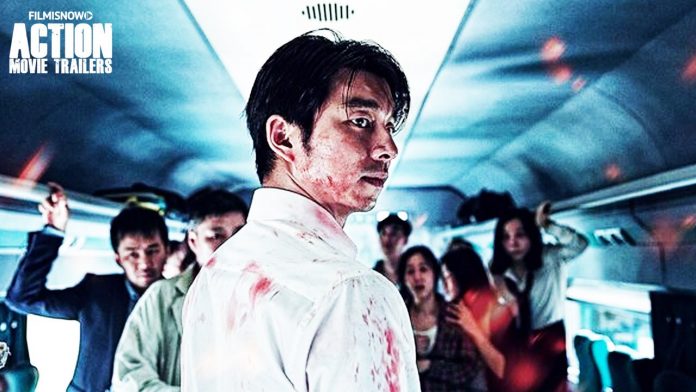ZOMBIES take over South Korea in Train to Busan, a relatively enjoyable take on the genre that mixes often genuine thrills with an unexpectedly use of emotional circumstances.
For a birthday treat, divorced businessman Seok-woo (Gong Yoo) takes his daughter Soo-an (Kim Su-an) onto a train to reunite with her mother, a way of apologising for missing a school performance which she fluffs as a result. Joining them on the train amongst many are a couple expecting a child, a high school basketball team and a pompous COO (Kim Eui-sung).
Just prior to the train departing, an infected woman manages to get on the train and soon, a concerned staff member checks on her, only to be infected in turn. As carriages of passengers become zombified, a group of survivors escape the carnage, Seok-woo and his daughter amongst them and find themselves secured from the infected.
However, their intended destination turns out to be filled with zombies too, and thus they are forced to head back onto the train and head to Busan, the one place of guaranteed safety. But a section find themselves in separate carriages far from others and it appears that the problems lie not just with the infected, but with the fellow survivors too.
Coming off not long from the recent British effort, The Girl with All the Gifts, whilst that played as more philosophical, this one plays as more popcorn-fare, but in a good way. It’s success mainly comes from making entertainment out of people escaping from zombies onboard the KTX (Korean Train Express).
With limited and claustrophobic space, the film does all it really can do with its zombies-on-a-train narrative but there are times when it is really fun to observe swarms of people fleeing and fighting off infected beings with limited weaponry.
In particular, it does well at crafting suspense namely when a band of survivors are forced to crawl upon the luggage sections of a carriage to get out of one carriage to another. By depicting characters taking advantage of the darkness and knowing that sudden noises will allow zombies to turn around, this places itself as just one of several tense scenes as the survivors move from one carriage to another.
Though horror fans are bound to appreciate this much more, there is reason that people who like being entertained and are not entirely squeamish will get this work too.
The actual moments when the outbreak begins and passengers flee for their lives helps redeem for a fairly basic first few minutes and from then on, there is an engagement that remains right until the end. It also makes good the use of automatic doors, whether letting survivors in reluctantly or preventing zombies from invasion that acts as a solid motif and an important factor regarding the story.
A sequence in which the passengers arrive at a seemingly quiet destination only to be greeted with an infected military and turns into a wild goose-chase to get on board the now moving train is typical. Yet it is the pace of the film as people get infected and others escape that the film works at doing what it says on the tin and this sequence is another example of sucking the viewer into an already likeable piece.
If there is another key aspect of the film worth detailing, it is that it succeeds with creating one of the most loathsome characters that will be seen in a picture this year, the aforementioned COO. Though one looks at his plight as one of desperation, his ruthlessness and determination to stay alive at all costs gradually makes us as viewers see him as someone just as dangerous as the infected.
It is he who leads a separated group of survivors who refuse to allow the other survivors into the carriage they take refuge in, unaware they are not affected. The character’s actions get progressively worse and it’s thanks to him that the work contributes significantly to what occurs in the final act.
It is this final act that the film succeeds at delivering an emotional centre but at the same time, frustrates too because of its guilt at using typical horror clichés.
As the final act pushes further, the body count of those who have been integral to the film suddenly starts rising, feeling rushed and depriving us of a more suited conclusion. It is true that it delivers an emotional aspect that works at moving the viewer which resonates long after the conclusion, but it is one that should have been done differently, preventing from ending with a happier ending that one would have preferred.
The film’s very final scene almost delivers a knockout blow that could have been a fatal move in spite of what was seen, but thankfully, gives the sense of fulfilment which acts as a remedy to what has occurred before in a moderate way.
It never feels like a game-changer and there are some structural issues, but Train to Busan works as an engaging horror that shows that this genre does not have to be exclusive to English-speaking countries.




























